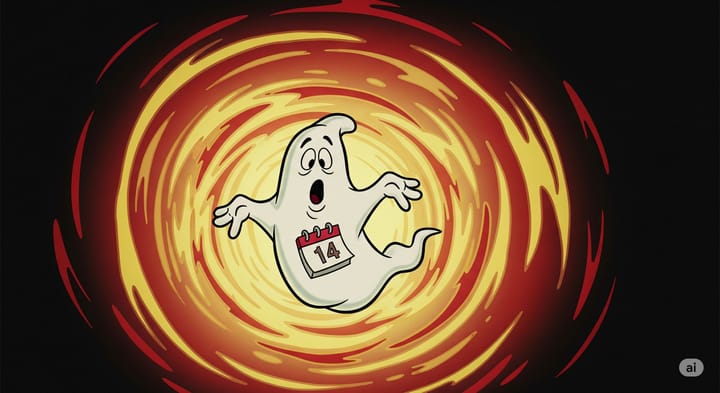The cost of saving sent e-mail

I don't tap my own phone. I don't xerox postcards before I mail them back from vacation. I don't take a voice recorder when I go out with friends. And I don't have a copy machine at home to duplicate hand written notes I may send.
But if I send a message of equal importance by e-mail, then my e-mail program will automatically save a copy of every one of these messages.
E-mails I don't need waste my time. They increase the time it takes to search and browse through old email. They increase the time it takes for my email to "sync" when I want to go offline. To continue to save every e-mail I send perpetuates the unsustainable myth that as long as our actions are online they are "green".
First the small action of saving a e-mail is amplified by the 1.5 billion people using e-mail globally. More saved e-mail means more disks to store the e-mail, larger backup systems to handle the volume, and faster processors so that all the archived messaged can be searched through efficiently. Since sent mail accumulates over time, an increasing amount of resources are needed to handle the saved mail. In five years there will be more people on the planet. It's likely a greater percentage will be sending e-mail, and likely the e-mail volume will be even higher than it as now. What is the energy cost, now and in the future, of storing so much e-mail?
While we can debate the magnitude of the impact, more data storage equals more resource consumption. In the United States, data centers already draw more power than our TV usage [1], and data centers are only part of the energy consumed by our increasingly networked life. In turn, about 40% of our water supply is devoted to generating power. Water is used in part to provide cooling massive data centers. (Only 15% of the water supply is actually used by the public). [2]
If you're with me on this one, here's one tip that could make big reduction in the size of your "Sent Mail" folder, while still retaining the memory the correspondence:
Consider not saving a copy of attachments you send in your Sent Mail folder. Attachments are often 10 to a 1000 times larger than a typical e-mail, and you already have a copy of the document on your hard drive. Plus, your recipient is about to receive a copy and she may then also download a copy from her e-mail to her hard drive. Saving the attachment in your Sent folder could mean keeping a forth copy of the document. If it's important to have a record that the attachment was sent, you could send one message with the correspondence that references the attachment, and save that a message. Then, send the attachment in it's own message, and don't save the attachment in the Sent folder.
Another idea: While some places have data retention rules (or laws!), these typically do not apply to personal e-mail accounts. Consider turning off the option to save e-mails by default, and conciously choose which e-mails you think are important enough to save. Note that Google's Gmail service (146 million users) does not have an option to turn off automatically saving the messages you send. Yahoo is another web-based e-mail provider that does provide this option. Check your e-mail program for details.
It is powerful to ask "what is the impact of this?", whether you consider e-mail storage, the toxic batteries in our cell phones, or the impact of broadcasting wifi radio waves through our homes 24/7. A daily choice such as a not saving an sent e-mail can be a mindful practice to connect our abstract online lives with the real world.
For details about calculating the carbon footprint of e-mail storage, read on.
Calculating the carbon footprint of e-mail storage
Research about the carbon footprint of e-mail storage turned up little in the way of existing estimates. emailfootprint.org estimated that it would take 1 kilowatt hour to store 1 Gigabyte of data for a year, but they didn't explain how they came up with that number, and the site is now offline, but accessible through the google cache
TreeHugger referenced a report that said that it would take 1 lb of coal to store 20 megabytes of data for a year, according to the US Department of Energy. But the report they linked to is no longer available. [3]
I decided to see if I could piece together my own estimate of the impact of storing sent e-mail, based on my own usage.
I have about 40 megabytes of mail saved from messages I sent in 2007. This perhaps already represents removing some messages which contained large attachments. For the sake of the example, let's assume this is an average amount. ( To personalize the example, check the size of your own Sent Mail folders!). Let's multiply this by an approximate 1.5 billion e-mailers and you get about 56 petabytes of data (about 58 million gigabytes). To picture that: imagine all the data was crammed on to reasonable large hard drives: 500 gigabytes each. It would take about 117,000 hard drives to store that data, assuming it was stored relatively efficiently and no extra space was required to store the operating system on this drives! The actual number is would be higher because much data can be expected to be on older hard drives, manufactured before the very large drives were an option. Further, it's an industry best practice to use always duplicate data using "RAID", so the same data would be written to at least two hard drives. Large providers such as Google may further be duplicating data in at least two data centers, for extra redundancy.
Using a number from here, I'll estimate that it takes 446 MegaJoules of energy to produce a hard drive, which I'll convert to 124 kilowatt hours. So, it would take about 14.5 million kilowatt hours of energy just to produce 117,000 hard drives, without getting into the energy required to keep them turned on.
Using data from US Department of Energy, it looks like we can expect about 2 lbs of CO2 to be generated to produce each kilowatt hour of energy.
So that puts us at an estimated 29 million lbs of C02 generated to produce enough hard drives to efficiently store all the sent e-mail in the world. (Using my own amount as an average).
To visualize that number, let's equate it the number of miles you'd have to drive in average car to generate the same amount of CO2. According to Streetsblog the average car generates 1.2 pounds of CO2 per mile, equating to about 24 million miles.
In perspective: 24 million miles is a very large absolute number, but it pales in comparison to the estimated 5 billion miles that American's drive each day. [4]. The real danger to address is the way of thinking that a digital paperless life is automatically green one.
This post is a follow-up to one entitled Stewardship and Sustainability of our Online Lives.
See Also
References:
- an EPA study stating that the data center industry devours 61 billion kWh of energy annually compared to ...about 275 million TVs currently in use in the U.S., consuming over 50 billion kWh of energy each year
- Quenching the Thirst of Power-Hungry Data Centers, citing primary data from the US government.
- The Footprint of Gmail: How Much Energy Would Deleting Email Save?
- Americans drive 5 billion miles per day



Comments ()